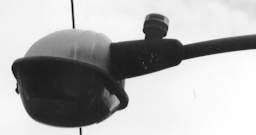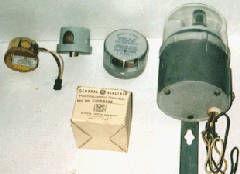

General Electric offered photoelectric lighting controls for street lighting purposes as early as 1934. These were tube-powered units were built within a 9-inch by 11-3/4 inch metal enclosure with a clear glass round window that exposed the phototube. These were very expensive at that time ($234 in 1934). Therefore less costly time switches and traditional means of manual control continued to dominate the method of operating street lighting circuits. By the late 1940's, tube-powered photocontrols became more affordable and subsequently replaced former methods of operating streetlights.
By 1950 General Electric began to offer photoelectric lighting controls integral with their fixture heads. Such individual operation was state-of-the-art in its day. These photoelectric controls were offered as an option for their incandescent and mercury (100 and 250 watt) luminaries. Through about 1960 their photoelectric lighting controls (fixture and bracket-mounted types) were of the tube-powered type and most had clear glass covers. They had three prongs that inserted into the fixture's or mounting bracket's receptacle, of a different configuration compared to other manufacturers. Succeeding these were plastic cover enclosed solid-state controls with a glass-enclosed cylindrical light-sensing phototube. These were of the twist-lock design. Photocontrols of most other manufacturers at the time (1961-64) had light-sensitive cadmium-sulfide light sensitive cells, which were much smaller and solid-state. General Electric manufactured vacuum phototube/solid-state or "hybrid" photocontrols until about 1964, when they became totally solid state.
Photocontrols manufactured by General Electric from 1961 through about 1968 were physically larger than those offered by most competitors. They were approximately 4 inches in diameter and 2-1/2 inches high. The 1961-64 units were painted silver on their interior with raised lettered nameplate data that was highlighted in blue. The aperture window on these earlier twist-lock controls was rectangular which allowed light to enter through to the horizontally mounted phototube that was about 1-1/2 inches long and about a half-inch in diameter. An adjustment screw controlled the amount of light that reached the cell via a shutter window that opened or closed, depending on the direction of turning the screw. Subsequent photocontrols had their solid-state light-sensitive photocells mounted immediately behind a round aperture opening that was about an inch in diameter. 120-volt models had solid gray plastic covers while 240-volt controls were blue.
During 1968 or 1969 General Electric introduced a smaller, "hat" shaped control. These typically were light gray and the company continued to produce them until sometime in the mid-1970's. After that time they pretty much got out of the photocontrol manufacturing business and offered controls of other companies, particularly Fisher-Pierce.
An innovative option that was available with most General Electric roadway and some area lighting luminaries was their "Astrodome" photoelectric lighting control. This compact unit was mounted integral within the fixture, held in place by a metal clip. Three wires extended from the control with a one-way, three wire plug on the other end which fit into the luminarie's wiring harness that provided easy photocontrol installation and removal. It was important that the Astrodome control's photosensitive cell faced upwards so that ample natural light would reach it. This control fitted immediately beneath an approximately 2-inch round opening in the fixture, where the twist-lock receptacle would ordinarily be. An opaque or clear plastic cover was permanently secured over the exterior of the Astrodome's fixture opening, protecting it from the elements.
Astrodome photoelectric lighting controls became available as a fixture option during 1962 or l963 and were popular with General Electric Power Bracket area lighting, open-bottomed mercury lighting fixtures introduced about that time. Interestingly, these controls employed simplified electronics and a solid-state photocell, compared to the more cumbersome and phototube twist-lock controls they had been making up until 1964. The Astrodome controls continued to be a General Electric option through the later 1970's. After then they were discontinued and standard photoelectric lighting control receptacles were used. Replacement controls for the Astrodome fixtures have been and still are available by other photocontrol manufacturers.
General Electric photocontrols were date coded by two letters. This identification appears as an ink stamp on the units' base. The first represented the month; the second for the year. Apparently the company used date codes in 20-year cycles. In 1965 the letter "A" designated the year code; "B" was for 1966 and so on. Prior to 1965, the same method was utilized; 1964 was represented by the letter "Y" ("Z" was omitted); "X" for 1963; "W" for 1962 and so forth, on back. Certain letters for year codes were not utilized through the years such as "I", "O", "Q" and "Z". General Electric street lighting luminaries and their components can be dated using the same key; 1986 fixtures had year codes beginning with the letter "A"; "B" for 1987, etc., representing the start of a continuing 20 year date coding cycle.
Photos of General Electric photocontrols
